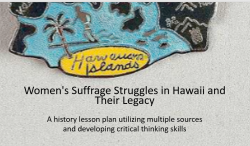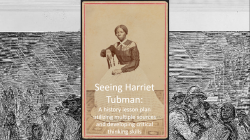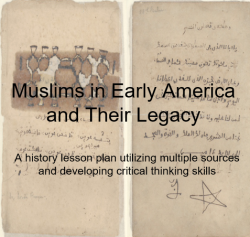Tim Roberts's collections
Sidedoor Listening Guide & Lesson Plan: Women's Suffrage Struggles in Hawaii and Their Legacy
<p>Overview<br><br>This lesson builds learning resources around a Smithsonian Sidedoor podcast episode (season 5, episode 12), "Votes for Hawaiians." The episode explores Hawaii's late independent and early territorial history 1820-1920, the contest for women's suffrage there, and racial and gender barriers to voting rights in America. Key individuals introduced are Emma Nakuina (1847-1929) and Wilhelmina Dowsett (1861-1929).<br><br>This lesson offers students the chance to use different kinds of sources - a podcast episode, a silent video, a political cartoon, the text of a law, and a modern news story - and analyze them interactively to answer critical thinking questions. Students should listen to the podcast in two parts and answer content-specific questions, then reflect on guiding questions specified for each class. Students may work with sources individually, but small group discussion of questions is encouraged.</p>
<p>Guiding questions<br></p>
<ul><li>How did Hawaiian women face 'double discrimination'?</li><li>What stereotypes did suffragists in Hawaii need to overcome?</li><li>How is Hawaii's legal status today a legacy of women's suffrage struggle there?</li></ul>
<p>Time 3 classes</p>
<p>Related resources<br></p>
<ul><li><em>Smithsonian Magazine</em> <a href="https://www.smithsonianmag.com/smithsonian-institution/how-19th-amendment-complicated-status-and-role-women-hawaii-180975551/">article</a> by Nora McGreevy, "How the 19th Amendment Complicated the Status and Role of Women in Hawai’i"</li><li>Smithsonian American Women's History Initiative <a href="https://womenshistory.si.edu/news/2020/08/eight-womens-voting-history-stories-you-may-not-know">article</a> by Ashleigh Coren and Sara Cohen, " Eight Women's Voting History Stories You May Not Know"</li></ul>
<p>If you are going to read just one book</p>
<ul><li><em>Finish the Fight!: The Brave and Revolutionary Women Who Fought for the Right to Vote, </em>by Veronica Chambers</li></ul>
<p>Glossary of key terms</p>
<ul><li>suffrage - the right to vote for candidates for public office, a fundamental element of democratic government</li><li>suffragists - advocates for the right to vote</li><li>missionaries - individuals sponsored by a church or other religious organization to live among and convert other people to share their beliefs; a list of missionaries to Hawaii is <a href="https://en.wikipedia.org/wiki/List_of_missionaries_to_Hawaii">here</a></li><li>oligarchy - a small, unelected group of individuals who control a country</li><li>annexation - acquisition of one country's territory by another</li><li>Jim Crow - an informal term for race-segregation laws in the United States from the 1880s through 1950s</li></ul>
<p></p>
<ul></ul>
<ul></ul>
<ul></ul>
<ul></ul>
 Tim Roberts
Tim Roberts
13
Sidedoor Listening Guide & Lesson Plan: Seeing Harriet Tubman
<p>This lesson builds learning resources around a Smithsonian Sidedoor podcast episode (season 5, episode 7), "Young Harriet." The episode discusses the 2017 acquisition of a photograph of the abolitionist Harriet Tubman (1822-1913) by the Library of Congress and the National Museum of African American History and Culture. The episode also introduces a friend of Tubman, the educator Emily Howland (1827-1929), who first collected the photograph, to show its value to our knowledge of Tubman.<br></p>
<p>This lesson offers students the chance to learn how archivists use photographs as historical evidence to detect information about a person's personality or life, and as evidence about the world that the person inhabited and her community. Students also interact with other visual and audio sources about Tubman, and test their ability to place artifacts in the right chronological order. </p>
<p>Students use different kinds of sources - a podcast episode, photographs and other historical images, and a modern song - and analyze them interactively to answer critical thinking questions. Students should listen to the episode in two parts and answer content-specific questions, then reflect on guiding questions specified for each class. </p>
<p>Guiding questions:</p>
<ul><li>Think about aspects of Harriet Tubman's life you learned about: an enslaved person, an underground railroad conductor, a US soldier, and an advocate of women's rights. What surprises you the most? Why is that?</li><li>How can a photograph be used to study a person’s character and circumstances or community?</li><li>How is a secondary or “after-the-fact” source different from a primary or “at-the-time” source? </li><li>What are skills you developed in this exercise helpful to analyze other visual sources?</li></ul>
<p>Time 2 classes</p>
<p>Related resources:</p>
<ul><li>National Portrait Gallery Portraits podcast <a href="https://npg.si.edu/podcasts/harriet-tubman">episode</a>, "Growing Younger with Harriet Tubman"</li><li>Smithsonian Magazine <a href="https://www.smithsonianmag.com/smithsonian-institution/why-harriet-tubmans-heroic-military-career-now-easier-envision-180975038/">article</a> by Alice George, "Why Harriet Tubman’s Heroic Military Career Is Now Easier to Envision"</li><li>Smithsonian Magazine <a href="https://www.smithsonianmag.com/smithsonian-institution/true-story-harriet-tubman-movie-180973413/">article</a> by Meilan Solly, "The True Story Behind the Harriet Tubman Movie" </li></ul>
<p>If you are going to read just one book:</p>
<ul><li><em>Harriet Tubman: Conductor on the Underground</em> by Ann Petry</li></ul>
<p>Glossary of key terms:</p>
<ul><li>Underground Railroad - a network of secret routes and safe houses established in the United States before and during the Civil War, and used by enslaved African Americans to escape into free states and Canada.</li><li>Wendell Phillips - an abolitionist, advocate for Native Americans, orator, and attorney.</li><li>Elizabeth Cady Stanton - a leader of the women's rights movement during the mid- to late-1800s, and main organizer of the 1848 Seneca Falls Convention, the first women's rights convention.</li><li>Susan B. Anthony - an antislavery and and women's rights activist who, with Stanton, in 1890 led formation of the National American Woman Suffrage Association.</li><li>Sojourner Truth - a woman who escaped slavery and became an abolitionist, women's rights activist, and recruiter of black troops for the US Army during the Civil War. At an 1851 women's rights convention, Truth delivered a famous speech now known as "Ain't I a Woman?" </li><li><em>carte de visite</em> - a type of small photograph invented by a French photographer Louis Dodero in 1854. <em>Cartes de visite</em> were the size of a modern business card, and were often traded among friends or presented by visitors.<br><br></li></ul>
<p></p>
<ul></ul>
<p></p>
 Tim Roberts
Tim Roberts
14
Sidedoor Listening Guide & Lesson Plan: Muslims in Early America and Their Legacy
<p><strong>Overview</strong><br></p>
<p>This lesson builds learning resources around a Smithsonian Sidedoor podcast episode (season 2, episode 17), "Enslaved and Muslim in Early America.." The episode focuses on what is known of the life of Omar ibn Said (1770-1864), a man from Senegal, West Africa. Said was enslaved and carried to the United States in 1807. He became the property of a prominent North Carolina family. In 1831, Omar wrote an autobiography. Rare enough as the narrative of an American slave, Omar’s autobiography is rarer still as a source revealing the mind and experiences of a 'founding father' of American Muslims. </p>
<p>This lesson offers students the chance to use different kinds of sources - a podcast episode, two short handwritten sources, a photograph, a map, a US federal law, two short articles about American history, and a captioned news photograph - and analyze them interactively to answer critical thinking questions. Students should work first with the two handwritten sources and photograph, then listen to the podcast episode in two parts, taking notes to answer content-specific questions concerning the various historical evidence. Finally, they should reflect on guiding questions specified for each class. Students may work with sources individually, but small group and discussion of questions is encouraged<br></p>
<p><strong>Guiding questions</strong></p>
<ul><li>What are some possible reasons that the history of early American Muslims is unknown?</li><li>Based on information in this lesson, was there religious <em>diversity</em> in the early United States? Was there religious <em>freedom</em> in the early United States?</li><li>What, in your view, are some popular perceptions of American Muslims today? How might the history of America's first Muslims in this lesson shape or reinterpret those perceptions?</li></ul>
<p>Time 3 classes</p>
<p><strong>Related resources</strong><br></p>
<p>Smithsonian Magazine <a href="https://www.smithsonianmag.com/smart-news/only-surviving-arabic-slave-narrative-united-statesdigitized-library-congress-180971298/">article</a> by Brigit Katz, "Only Surviving Arabic Slave Narrative Written in the United States Digitized by Library of Congress," January 18, 2019</p>
<p>National Museum of African American History & Culture <a href="https://nmaahc.si.edu/explore/stories/collection/african-muslims-early-america">exhibit</a>, "African Muslims in Early America," January 11, 2019</p>
<p>Smithsonian Folklife Festival <a href="https://festival.si.edu/blog/what-does-it-mean-to-be-american-muslim">blog</a> by Michelle Mehrtens, "What Does It Mean to Be American Muslim?" August 21, 2017</p>
<p><strong>If you are going to read just one book</strong></p>
<p><em>Copper Sun, </em><em> </em>by Sharon Draper</p>
<p><strong>Glossary of key terms</strong></p>
<ul><li>mescid - a mosque, or a place of worship for Muslims</li><li>imam - a worship leader of a mosque and/or a Muslim community</li><li>Lord's Prayer - a prayer of Christians, using words taught by Jesus</li><li>Nat Turner – a man enslaved near Richmond, Virginia, who in 1831 led the largest slave uprising in United States history </li><li>Malcolm X - an American Muslim minister and human rights activist who was a popular figure during the civil rights movement</li><li>Muhammad Ali - a famous American professional boxer who gained controversy during the civil rights movement for refusing, partly on the basis of his religious beliefs as a Muslim, to be drafted into the military</li></ul>
<p></p>
 Tim Roberts
Tim Roberts
15




